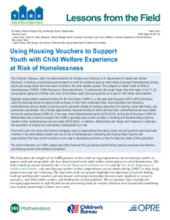The Children’s Bureau, within the Administration for Children and Families (U.S. Department of Health and Human Services), is funding a multi-phase grant program to build the evidence base on what works to prevent homelessness among youth and young adults who have been involved in the child welfare system. This program is called Youth At-Risk of Homelessness (YARH). YARH focuses on three populations: (1) adolescents who enter foster care from ages 14 to 17, (2) young adults aging out of foster care, and (3) homeless youth and young adults up to age 21 with foster care histories.
Eighteen organizations received funding for the first phase (YARH-1), a two-year planning grant (2013–2015).Grantees used the planning period to conduct data analyses to help them understand their local population and develop a comprehensive service model to improve youth outcomes related to housing, education and training, social well-being, and permanent connections. Six of those organizations received funding to refine and test their comprehensive service models during the second phase (YARH-2), a four-year initial implementation grant (2015-2019). During the third phase (YARH-3), Mathematica will continue to support the YARH-2 grantees (also known as sites) in building and disseminating evidence related to their comprehensive service model (2019-2024). In addition, Mathematica will design and implement a federally-led evaluation of at least one intervention implemented by a site.
This brief is part of a series that shares strategies used by organizations that serve youth and young adults who have been involved in the child welfare system and are at risk of homelessness. Collecting and sharing these lessons with organizations that have similar missions is one step in developing evidence on how to meet the needs of this population.

